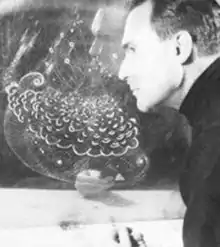Ian Hugo
Hugh Parker Guiler (February 15, 1898 – January 7, 1985), also known as Ian Hugo, was Anaïs Nin's husband from 1923 until her death in 1977, and a skilled engraver and filmmaker in his own right.
Hugh Parker Guiler | |
|---|---|
 | |
| Born | February 15, 1898 Boston, Massachusetts, U.S. |
| Died | January 7, 1985 (aged 86) New York City, U.S. |
| Spouse(s) | |
Biography
Guiler was born in Boston, Massachusetts, lived in Puerto Rico as a child, went to school in Scotland, and graduated from Columbia University where he studied economics and literature.
He was working at National City Bank when he met Anaïs Nin. They married in March 1923. In 1924, they moved to Paris, and in that city Nin's wrote the best known part of her famous diary. In 1939, shortly before World War II, Parker and Nin moved back to New York City. In 1940, he took up engraving and etching, studying under Stanley William Hayter of Atelier 17 in Paris, producing surreal images that often accompanied Nin's books. He received advice and instruction in filmmaking from Alexander Hammid, who told Guiler "Use the camera yourself, make your own mistakes, make your own style". He adopted the name Ian Hugo in the 1940s when he began making experimental films, some starring Nin.
His successful banking career supported not only the very late recognized artistic work of his wife, and later his own, but also Henry Miller's and to a lesser extent various others. His unusual tolerance and unconditional love, as well as his income, made Anaïs's unusual work and life possible. Because of Anaïs's Madame Bovary way with money, his dedication to the arts and taking more risks later in life, he needed the money that Anaïs's writing brought so late in their lives. His own art was never financially successful.
The film Bells of Atlantis (1952) features a soundtrack of electronic music by Louis and Bebe Barron, and stars Nin as a mythical queen of Atlantis. In Jazz of Lights (1954), also featuring a score by the Barrons, the street lights of Times Square become, in Nin's words, "an ephemeral flow of sensations."
Hugo lived the last two decades of his life in New York City, dictating his memoirs and continuing his engraving and filmmaking work. He briefly met Nin's other husband, Rupert Pole, after Nin's death in 1977. Even though Nin and Pole's 1955 marriage was annulled in 1966, Pole was Nin's literary executor after her death; after Guiler's death, Pole scattered his ashes at the same place as Nin's, a cove on the coast at Santa Monica.[1]
Selected filmography (as Ian Hugo)
- Ai-Ye (1950)
- Bells of Atlantis (1952)
- Jazz of Lights (1954)
- Melodic Inversion (1958)
- The Gondola Eye (1963–71)
- Through the Magiscope (1969)
- Apertura (1970)
- Aphrodisiac I (1971)
- Aphrodisiac II (1972)
- Ian Hugo: Engraver and Filmmaker (1972)
- Levitation (1972)
- Transmigration (1973)
- Transcending (1974)
- Luminiscence (1977) made with Arnold S. Eagle
- Reborn (1979)
References
- Corbett, Sara (31 December 2006). "The Lover Who Always Stays". The New York Times. Retrieved 20 May 2020.
External links
- Ian Hugo at IMDb
- Fox, Margalit. (July 30, 2006). "Rupert Pole, 87, Diarist's Duplicate Spouse, Dies", The New York Times
